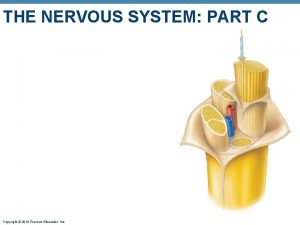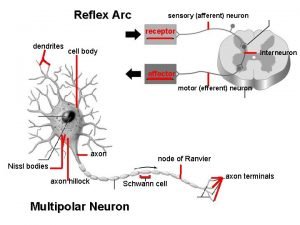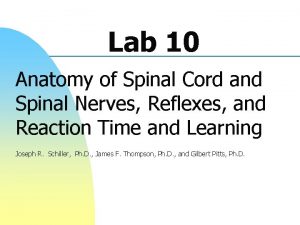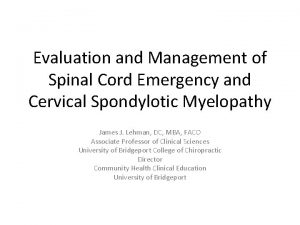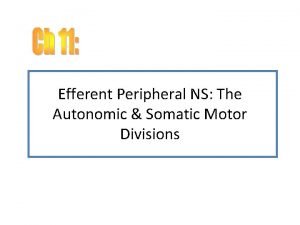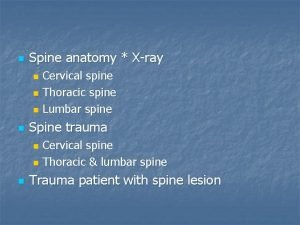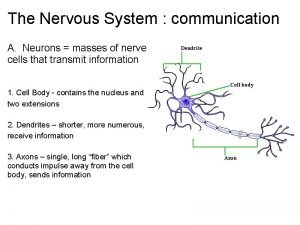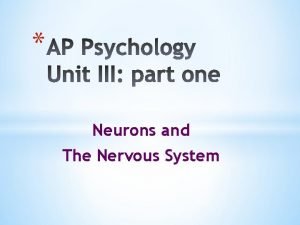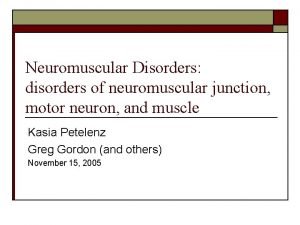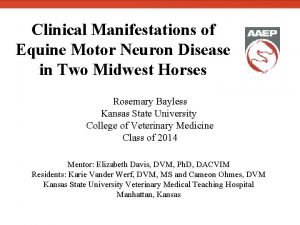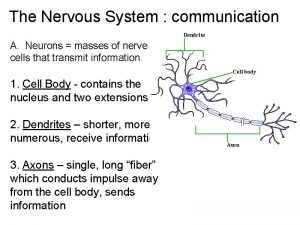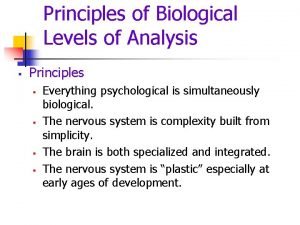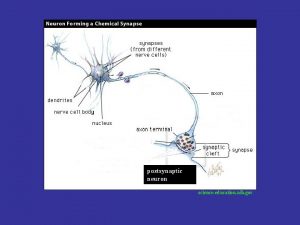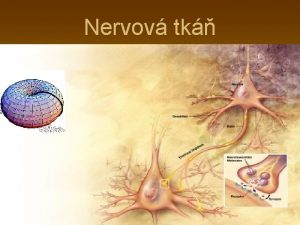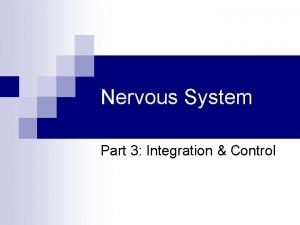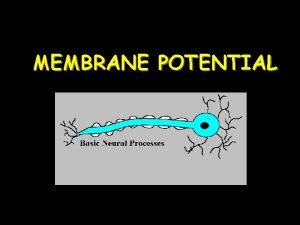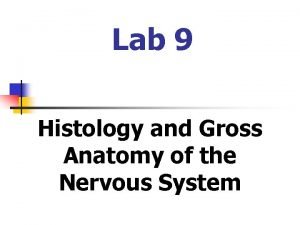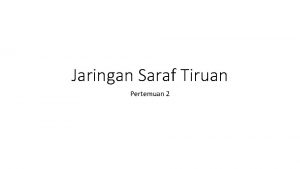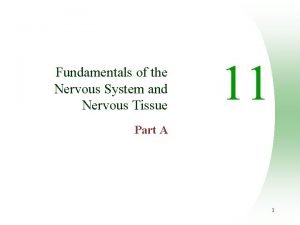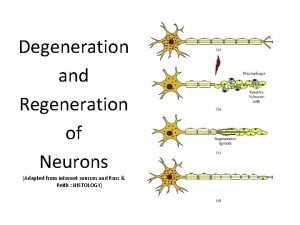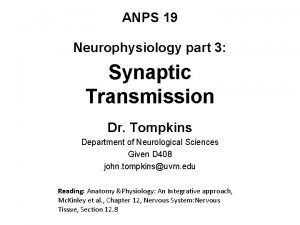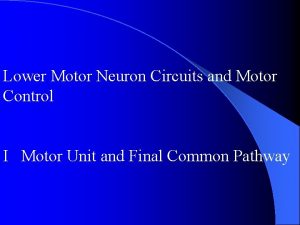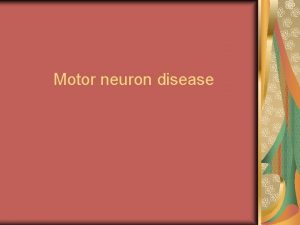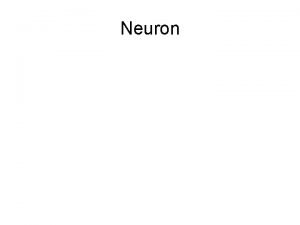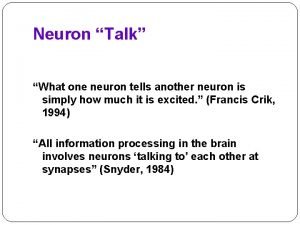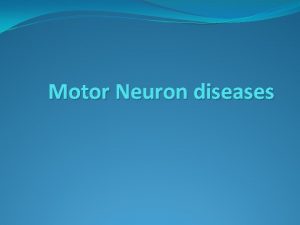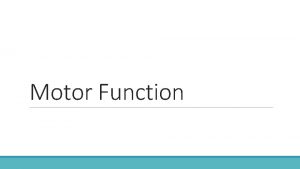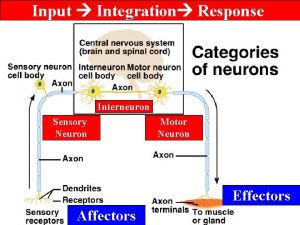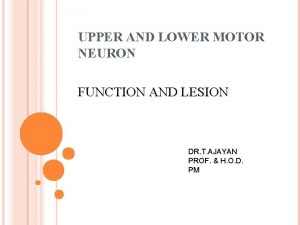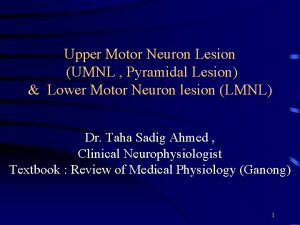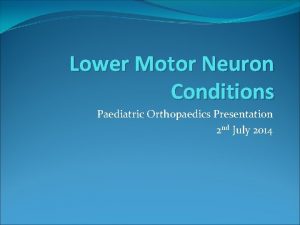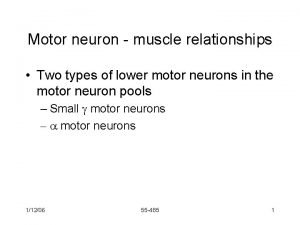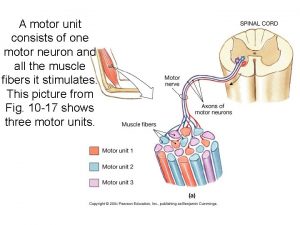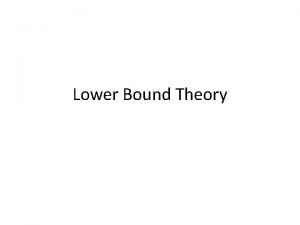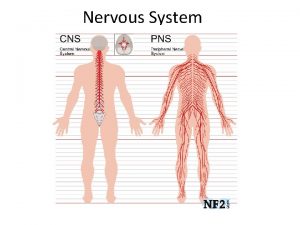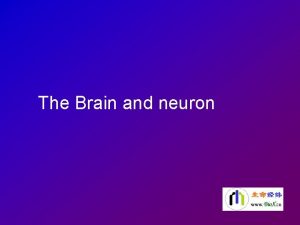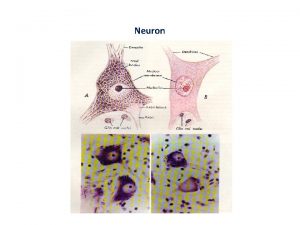Ch 15 Lower Motor Neuron Circuits and Motor


































- Slides: 34

Ch. 15: Lower Motor Neuron Circuits and Motor Control - a model for understanding the nervous system 1/19/2022 55 -485

Neural centers responsible for movement • 4 interactive subsystems contribute to motor control 1/19/2022 55 -485

Neural centers responsible for movement 1) Gray matter of spinal cord and brainstem - local motor neurons innervate skeletal muscle cells - motor neurons of cranial nerves from cell bodies in the brain stem - local circuit neurons are the major source of synaptic input to the lower motor neurons. 1/19/2022 55 -485

1/19/2022 55 -485

Neural centers responsible for movement 2) Upper motor neurons - cell bodies in brainstem or cerebral cortex 1/19/2022 55 -485

1/19/2022 55 -485

1/19/2022 55 -485

Neural centers responsible for movement 3) Cerebellum - regulate activity of upper motor neurons 1/19/2022 55 -485

1/19/2022 55 -485

Neural centers responsible for movement • 4) Basal Ganglia • Regulate upper motor neurons 1/19/2022 55 -485

1/19/2022 55 -485

Basal ganglia - caudate, putamen, globus pallidus -subthalamic nucleus, substantia nigra 1/19/2022 55 -485

1) Gray matter of spinal cord and brainstem • Lower motor neurons send axons out of the brain stem and spinal cord to innervate skeletal muscles of the head and body. 1/19/2022 55 -485

Gray matter of spinal cord and brainstem • Local circuit neurons – Synaptic input to lower motor neurons 1/19/2022 55 -485

Gray matter of spinal cord and brainstem • Lower motor neurons convey voluntary and reflex commands to skeletel muscle 1/19/2022 55 -485

Gray matter of spinal cord and brainstem • Local circuit neurons – Receive descending projections from higher brain centers – Also receive sensory input from higher brain centers 1/19/2022 55 -485

Gray matter of spinal cord and brainstem • Circuits provide co-ordination between muscle groups for movement – Are the final common path for movement. 1/19/2022 55 -485

1/19/2022 55 -485

2) Upper motor neurons • Cell bodies in the brainstem or cerebral cortex • Axons descend to synapse with local circuit neurons, sometimes directly onto lower motor neurons 1/19/2022 55 -485

2) Upper motor neurons • In the cortex – Initiate voluntary movements – Initiate complex spatiotemporal sequences of skilled movements – E. g. descending projections from the frontal lobe (primary motor cortex and lateral premotor cortex) 1/19/2022 55 -485

2) Upper motor neurons • In the brainstem – Regulate muscle tone for orienting eyes, head and body wrt sensory information (balance, somatic, sound, vision input) – Imp. For movement and posture 1/19/2022 55 -485

3) Cerebellum • Does not directly access local circuit neurons or lower motor neurons • Regulate the upper motor neurons • Located on the dorsal suface of the pons 1/19/2022 55 -485

3) Cerebellum • Detects the difference between an intended movement and the movement that is actually performed (servomechanism) • Reduces movement error in short term and in long term (learning) eg. Riding a bike. 1/19/2022 55 -485

4) Basal ganglia • No direct access to local circuit neurons or to lower motor neurons • Regulate upper motor neurons • Suppress unwanted movement • Prepare upper motor neurons for movements to start 1/19/2022 55 -485

How does thought lead to movement? • Still poorly understood • Clear picture at the level of muscles themselves. • Start with the lower motor neurons and their targets. 1/19/2022 55 -485

Motor neuron - muscle relationships • Neuronal tracer injections into the cell body show the pathway on motor neuron axons • motor neuron pools are all of the motor neurons that innervate a muscle. 1/19/2022 55 -485

Motor neuron - muscle relationships • Motor neuron pools run together in the spinal cord. • An orderly arrangement between the motor neuron pools and the muscles that they innervate*** - a rule for the nervous system (mapping, topography) 1/19/2022 55 -485

Motor neuron - muscle relationships • Fig. 15. 3 – Topography – Neurons for postural muscles are medial in the cord – Neurons for the shoulders are next most lateral – Neurons for upper arms are next lateral. – Neurons for distal extremeties are most lateral. 1/19/2022 55 -485

Motor neuron - muscle relationships • Spatial organization gives information about functions 1/19/2022 55 -485

Motor neuron - muscle relationships • Two types of lower motor neurons in the motor neuron pools – Small motor neurons – motor neurons 1/19/2022 55 -485

1/19/2022 55 -485

Small motor neurons • Innervate sensory structures in skeletal muscle (muscle spindles) • Muscle spindles are embedded in connective tissue – Are called intrafusal muscle fibers 1/19/2022 55 -485

Small motor neurons • In Intrafusal muscle fibers – Sets the intrafusal muscle fiber to an appropriate length for the sensory neuron to function. 1/19/2022 55 -485

motor neurons • Large • Innervate extrafusal muscle fibers. These generate force for movement and posture. 1/19/2022 55 -485
 Lower
Lower Lower motor neuron
Lower motor neuron Zapojenie alternatora
Zapojenie alternatora Motor neuron vs motor unit
Motor neuron vs motor unit Series parallel circuit current
Series parallel circuit current Site of somatic motor neuron cell bodies
Site of somatic motor neuron cell bodies Site of somatic motor neuron cell bodies
Site of somatic motor neuron cell bodies Clonus
Clonus Somatic motor neuron
Somatic motor neuron Soap note
Soap note Somatic motor neuron
Somatic motor neuron Parasympathetic nervous system
Parasympathetic nervous system Alpha and gamma motor neurons
Alpha and gamma motor neurons Somatic nervous system
Somatic nervous system Nipple line t4
Nipple line t4 Upper motor neuron
Upper motor neuron Motor neuron adalah
Motor neuron adalah Motor neuron adalah
Motor neuron adalah Motor neuron
Motor neuron Equine motor neuron disease
Equine motor neuron disease Neuroglial cells
Neuroglial cells All or none law
All or none law Postsynaptic neuron
Postsynaptic neuron Cerebral cortex reflex
Cerebral cortex reflex Blood vessel
Blood vessel Three basic parts of a neuron
Three basic parts of a neuron The resting membrane potential of a neuron is
The resting membrane potential of a neuron is Vermis sheep brain
Vermis sheep brain Buatlah model neuron mcp untuk menyatakan fungsi logika or
Buatlah model neuron mcp untuk menyatakan fungsi logika or Neuronal pool
Neuronal pool Convergence vs divergence neurons
Convergence vs divergence neurons Central chromatolysis
Central chromatolysis A neuron without terminal buttons would be unable to
A neuron without terminal buttons would be unable to Anatomy of a synapse
Anatomy of a synapse Refractory period in action potential
Refractory period in action potential





